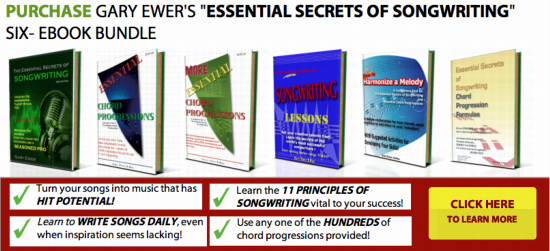A sequence in songwriting has the benefit of tightening and strengthening musical phrases.
You may be writing songs every day, but are you just reinforcing songwriting errors?
Download “The Essential Secrets of Songwriting” 6-ebook bundle, and solve your songwriting problems today.
______________
 In music, a sequence is a short melodic idea with accompanying chords that then gets immediately repeated, usually at a lower pitch. Such a sequenced phrase will get played 2 or 3 times before moving on to something else. A current example from the Billboard Hot 100 is Train’s hit, “50 Ways to Say Goodbye.” The opening melodic line (“My heart is paralyzed…“)is then sung a scale step lower (“My head was oversized…”). A 3rd phrase begins the same way but changes.
In music, a sequence is a short melodic idea with accompanying chords that then gets immediately repeated, usually at a lower pitch. Such a sequenced phrase will get played 2 or 3 times before moving on to something else. A current example from the Billboard Hot 100 is Train’s hit, “50 Ways to Say Goodbye.” The opening melodic line (“My heart is paralyzed…“)is then sung a scale step lower (“My head was oversized…”). A 3rd phrase begins the same way but changes.
The accompanying chords also move down by scale steps: Ebm Abm |Db Gb | Cb Ebm… Just to clarify, a scale step means that if your song is in, let’s say, C major, and the melody starts on a C, “sequencing it downward” means that the next phrase will start on a B.
This kind of sequencing is very common in the Classical world, and not so common in the pop world. As you can hear, the result of melodic and harmonic sequencing in this manner is that the chords are very strong, and the melodic shape is predictable. This is because once you start the second leg of your sequence, listeners can easily anticipate where the melody is moving.
Another good example from the pop world of sequencing is in the verse of Dusty Springfield’s huge 1966 hit, “You Don’t Have to Say You Love Me” (written by Pino Donaggio and Vito Pallavicini ). The first line of melody is repeated twice, moving down by a tone each time, before finally changing to something different.
It’s an interesting compositional exercise for songwriters, and so if you want to try your hand at writing sequences, here are steps you can follow (keeping in mind that there are actually many ways to write a sequence):
- Choose a key, and write out the 7 chords that exist naturally in that key. For example, C major gives you these 7: C Dm Em F G Am Bdim). If you need a refresher for how to know which chords belong to a key, read this article.
- Create a simple 2-chord progression. Your most satisfying attempts at this will happen when your chosen chords are a 4th or 5th away from each other, such as C – F.
- Create a basic melodic shape that works well with your chosen chords.
- Move your chords and melody downward so that they start one scale-step lower. If, for example, your melody starts on an E while your progression is C-F, the next phrase will start on a D and the accompanying chords will be Bdim-Em.
- Repeat step 4. It’s during this step that many songwriters will choose to modify something so that they can bring the phrase to a satisfying close. In other words, it starts like it’s going to be a simple repeat, but changes. This is what happens in both “50 Ways” and “You Don’t Have to Say You Love Me”.
The benefit of sequencing in this way is also its danger: it produces chords and melodies that are predictable once they get going. But it’s a great way to strengthen your melody writing, and it can serve as a good way to start a song before branching off and doing something else.
_______________
Follow Gary on Twitter










